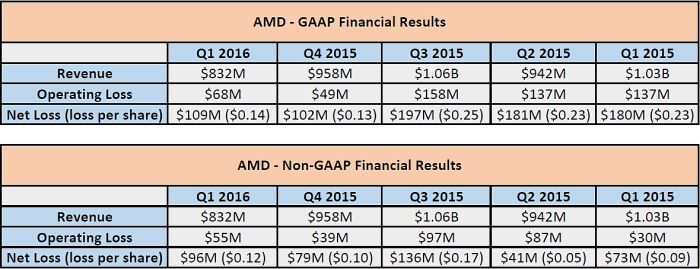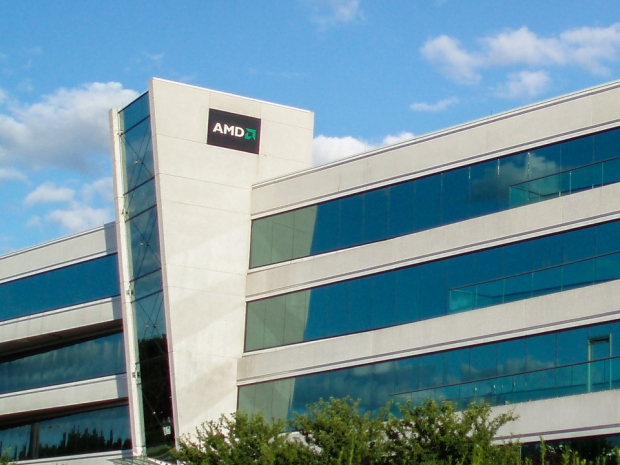In both non-adjusted and GAAP-adjusted financial results, we are now looking at $832 million in revenue for Q1 2016, down from $958 million in Q4 2015 and $1.06 billion in Q3 2015.

Source: AMD Investor Relations
From the 13-week quarter ending April 21st, AMD reported an operating loss of $68 million (compared to an operating loss of $49 million in Q4 2015), and a non-GAAP operating loss of $55 million (compared to non-GAAP operating loss of $39 million in Q4 2015). Revenue was $832 million, down 13 percent sequentially. In particular, the company's Computing and Graphics segment revenue was down 2 percent from Q4 2015 mainly due to decreased sales of client desktop processors. On the other hand, Enterprise, Embedded and Semi-Custom segment revenue was down 24 percent sequentially mainly due to lower semi-custom SoC sales.
AMD's full Q1 2016 earnings transcript can be found here.
In the next few months, AMD executives are banking entire segments and large portions of the company's performance in the last months of 2016 on a basic assumption that revenue upswing will result from its Zen FX CPUs in Q4 as well as Zen x86-based APUs in early 2017. These chips are expected to deliver graphics performance equivalent to the PlayStation 4 (similar to Radeon 7870 with two CUs disabled) and the Xbox One (similar to Radeon HD 7790 with two CUs disabled).
On Wednesday, we wrote about AMD's $293 million joint venture deal with China-based Sugon company, where the company will develop SoCs for server-based products being delivered to the Chinese Academy of Sciences. While details remain scarce at this point, it is very possible that AMD could incorporate its high-end Zen x86 APU with Greenland GPU featuring High Bandwidth Memory 2.0, support for DDR4 and a very fast interconnect with coherent fabric.
“Our new licensing agreement is a great example of leveraging our strong IP portfolio to accelerate the adoption of our technologies more broadly,” said Dr. Su. “The joint venture with THATIC provides AMD with a differentiated approach to help gain share in the fastest growing region of the server market.”
“Our strategy to build a strong business foundation and improve financial performance through delivering great products is beginning to show benefits,” said Lisa Su, AMD president and CEO. “We continued to strengthen the performance of our Computing and Graphics business as our customers and partners show a growing preference for AMD. We are optimistic about our growth prospects in the second half of the year across our businesses based on new product introductions and design wins.”
The company expects to return to non-GAAP operating profitability in the second half of 2016.
In January, the company launched its first 64-bit ARM-based product, the 28nm Opteron A1100 “Seattle” SoC with up to eight Cortex A57 cores as we highlighted back in May 2014. But the big "design wins" it is referencing will come from the Zen x86 CPU architecture. These high-performance AMD chips will be manufactured by TSMC on its 16-nanometer FF+ process which began volume production in Q4 2015. Nvidia is also producing its 16nm Pascal chips with TSMC, and AMD has also decided to become their customer for its Polaris GPUs arriving in June. More specifically, they are preparing to use manufacturing designs from both TSMC and GlobalFoundries for these upcoming FinFET-based GPUs.
AMD's hopes for 2H 2016 and onwards are very reminiscent of the U.S. presidential election. As it stands, the information technology sector is relying heavily on the company's revenue comeback for quarterly economic growth as a result of increased competition in the high-end CPU market with Intel.
This is especially important as the blue company recently announced 12,000 job cutbacks and a near-term philosophical shift away from the PC market. Intel is now focused more on programmable CPUs and memory chips. If the market is to benefit consumers, however, both companies will need to remain strong in traditional desktop / ultrabook / 2-in-1 PC market sales as well as mobility GPUs (Radeon Mobility / Intel Iris) for the healthiest possible bottom-line market outcome in Q1 2017.




